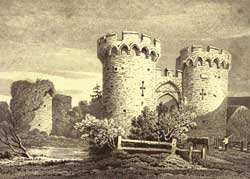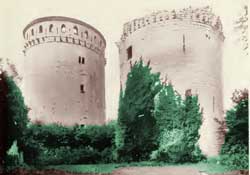Medieval Castles
In their early stages the Medieval castles had a simple layout, basically an embankment with a wooden stockade thrown round a private villa or simply a farm. Their appearance was similar to the community fortifications built for the protection of the towns, but the idea behind them was totally different.
Early Medieval castles
In Medieval France, castles are mentioned in records dating back to 864. It was the year when the Edict of Pistes ordered the destruction of all castles built without royal licence.
Whether these castles were provided with towers is hard to say. We hear of towers in connection with the great towns, which, whether they were originally mural towers or not, were evidently private strongholds, and may justly be called keeps.

Cowling Castle
England
A very early instance of a Middle Ages castle is that of Nantes, built by Bishop Fulcher in 889. Later, the records are mentioning Count Alan Barbetorte (937-943), who restored the principal tower and made it into his own house. Another instance is in 924, when the tower of the presidium where Herbert, Count of Vermandois, had imprisoned Charles the Simple was burnt accidentally. The same castle tower was restored, as nine years later it withstood a six weeks siege from King Raoul.
Count Herbert built a keep in Laon before 931, which was a different tower to the one attached to the royal house which Louis d'Outremer had built at the gate of the city. There are records of towers at Amiens (950), Coucy (958), Chalons (963), and Rheims (988). All these towers were connected with towns.
The first Medieval castle with a stone keep for whose date we have positive evidence, is that of Langeais, built by Fulk Nerra, Count of Anjou, about the year 994, which still exists.
Now we can go into more details, with some considerations about the English castle, and the Medieval castle layout, with references to the motte and bailey castles. Because we are already entering the stone Medieval castles era, we will also attempt a classification with a focus on the stone keep fortifications.
Classification and layout of Middle Ages castles
There are various opinions in classifying the castles of the Medieval period. Perhaps the best is the one based on the type of defense adopted. According to this system, the presence or absence of the great and distinguishing feature, the keep, divides the castles in two main types:
1. The Keep castle.
2. The Keepless castle.
The Keep Castle types:Based on the shape of the tower, the castles with keeps can be:
The first two castles groups are typical of the Norman period. The third had his origins in Norman times and, in England, lasted till the days of the Edwards. It may be considered as belonging especially to the reigns of Richard and John and to the earlier part of that of Henry III, that is to the beginning period of what is known architecturally as Early English.

Medieval French Castles:
Coucy
The differences in keepless castles layout allow us to identify three main groups:
a. Castles of Enceinte, were the keep was discarded and its place taken by a main ward, surrounded by a lofty wall of enceinte, flanked by boldly projecting mural towers usually cylindrical in form, containing the state and domestic apartments. These castles belong for the most part to the later years of the long reign of Henry III, and to that of his successor.
b. The Edwardian or Concentric Castles, in which the main ward is completely surrounded by a second, and sometimes a third line of defense, subordinated to and commanded by the inner one.
c. The "Later Medieval Castles" in which the idea of defense was more or less subordinated to that of domestic comfort. They had usually a quadrangular layout, built around an inner courtyard with towers, almost invariably rectangular at the corners, and with a great gate-house in the middle of one face. Castles of this type began to be built during the reign of Richard II, and became increasingly common in the 15th Century.
Finally, we look at two fine examples of Medieval castles renowned for their innovations in military architecture, Château Gaillard, and the Coucy Château, the latter boasting the tallest keep ever.
